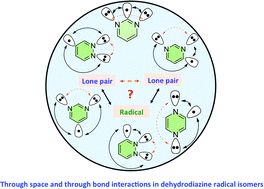Through bond and through space interactions in dehydro-diazine radicals: a case study of 3c-5e interactions†
Abstract
Owing to the 3c-5e (3-centred-5-electrons) interactions between two nitrogen lone pairs and a radical electron, the dehydrodiazine radical isomers are very interesting from the fundamental point of view. Among them, pyrimidine has three (1a–1c), pyridazine has two (2a and 2b) and pyrazine has only one (3a) radical isomer. Based on quantum chemical calculations at the (U)B3LYP, (U)M06-2X, (U)BLYP, CBS-QB3 and (U)CCSD(T) levels with cc-pVTZ as the basis set, we found the 4-dehydropyrimidine (1b) radical to be the most stable isomer among the three pyrimidine radicals, followed by the 2-dehydropyrimidine (1a) and 5-dehydropyrimidine (1c) radical isomers. In the case of pyridazine, 3-dehydro radical isomer (2a) is more stable than 4-dehydropyridazine (2b). Bond dissociation energy (BDE) calculations and estimation of radical stabilization energies (RSE) using isodesmic reactions revealed the stability order among the six isomeric diazine radicals as 1c < 2b < 2a < 1a < 3a < 1b. Spin densities at each radical centre and non-zero values at nitrogen centres provided information about the extent of delocalization of radical electrons, which was consistent with the relative stability order of all the isomers. The multiconfigurational CASSCF and natural bond orbital (NBO) calculations suggested the presence of direct through space interactions (between lone pairs and a radical, TS) that play a dominant role over the through bond (through intervening bonds, TB) interactions in deciding the stability order. To confirm these results, we have also estimated the proton affinities (PAs) for each nitrogen atom and compared them with their respective parent diazines, where lowering of the PA values convincingly envisaged the extent and strength of interactions between the nitrogen and radical centre. Atoms-in-molecules (AIM) analysis and estimation of hyperfine coupling constants have also been performed to verify these results. All these results showed that the through space interaction between the lone pair and the radical electron is very important for the electronic structural and stability aspects in dehydrodiazine radicals.



 Please wait while we load your content...
Please wait while we load your content...